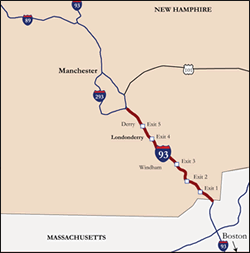FHWA Localized Bottleneck Reduction Program
Case Study
Printable Version [PDF 103KB]
You may need the Adobe® Reader® to view the PDF on this page.
Contact Information: Neil Spiller at Neil.Spiller@dot.gov
 Study Area (map "for placement only")
Study Area (map "for placement only")
Location – Manchester, New Hampshire
Interstate 93 from the Massachusetts state line north to Manchester (19.8 miles).
Problem – Signalized ramps back up onto mainlane during peaks
This existing 19.8-mile four-lane section of I-93 was originally built in the 1960s and since that time, the facility has not undergone any major system wide upgrades or modernization. The interchanges at Exits 2, 3, and 5 remain essentially as they were originally constructed. Exits 1 and 4 were partially reconstructed in the late 80s and early 90s, but are rapidly becoming incapable of meeting traffic demand. To address these problems, NHDOT identified a major, multiyear reconstruction project. The project will include: widening the mainline from two to four lanes per direction; widening of 44 bridges; reconstruction of all five interchanges on the section; addition of sound barriers; construction of three new park and ride lots; expanded bus service; and the purchase of right-of-way for a future light rail line. However, because this project has an ambitious scale, it will take several years to complete and major congestion now occurs at Exit 5.
Solution – Convert shoulder to deceleration lane
The State of New Hampshire has selected work at Exit 5 (Londonderry) on I-93 to be expedited in order to address the bottlenecking concerns which currently exist. The signalized northbound and southbound ramps back up onto the mainline during peaks. The original project called for much of Exit 5 to be reconstructed in FY 2009. In partial response to the LBR program attention, improvements to two of the existing ramps are being expedited. The southbound off ramp at Exit 5 will be extended. The shoulder area on the mainline will be widened and reinforced to hold some of the queue. The signal at the top of the ramp will be coordinated with loop detection. Reconstruction or widening of two nearby bridges will be accomplished. The estimated cost of this expedited work is $9.13 million. The completed project will meld into the overall 19.8-mile I-93 project.
Lesson Learned
This project demonstrates that existing bottlenecks can be effectively dealt with in the context of "mega-projects." By identifying current problems and scheduling partial improvements that fit into the overall context of major reconstruction, existing congestion can be addressed.